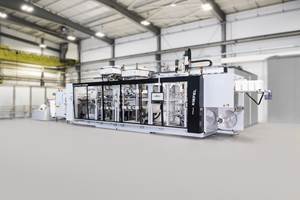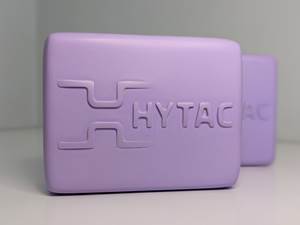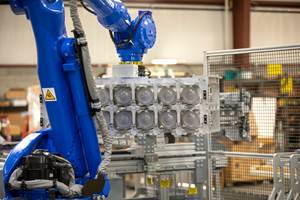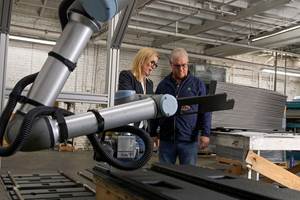Plug-Assist Coating Improves Surface Quality and Formability
Manufacturers and users of plug-assist tooling have a new technique to improve the surface finish and cycle time of thermoformed parts.
Manufacturers and users of plug-assist tooling have a new technique to improve the surface finish and cycle time of thermoformed parts. A novel coating reportedly improves tool surface finish and eliminates cleaning and part rejects. It is claimed to be less costly than other options, such as release agents.
BUILT-IN RELEASE
In a slightly different version, this tool coating from Dimension Bond Corp. is already used on glass-reinforced injection molded parts that are used in sliding or rotating applications. The coating reduces friction and covers protruding fibers that cause wear on mating parts. The coating does much the same thing for plug-assist tooling made of glass-reinforced thermoplastics by providing wear resistance for plug durability, as well as low friction and a smooth surface that won’t mar the formed parts. Demand is strong in plug-assist tooling because the industry is seeking labor- and cost-saving techniques, according to Bruce Nesbitt, Dimension Bond president.
The company developed a special two-layer “composite” coating that is applied as a liquid to the plug and cures to form a strong adhesive bond. The coating for thermoform tooling is different from those tailored for injection molded parts because the film needs the added capability to release the product. The new “tooling class” of coatings has a smooth yet ultra-long-wear surface that prevents scratching the plastic sheet. Not only does the coating film cover any reinforcing fibers protruding from the plug surface, it allows formed parts to be removed from the mold with minimal effort and no additional mold release.
The two-layer coating consists of a top layer of PTFE, which provides low friction and release, and an under-layer of specially formulated carbon and ceramic nano-particles in a polyimide or polyamide-imide resin matrix that bonds to the plug-assist. A special silane coupling agent bonds the matrix layer to the plug assist.
The liquid coating is applied and cured on the plug assist using Dimension Bond’s proprietary computer-controlled process. It is applied to the entire plug surface and there is no limitation on plug size. First, the silane solution is applied to the plug and then the matrix layer is applied and then cured at 350 F for 60 to 90 min. The final step is bonding the PTPE top layer using infrared curing. The plug is rotated during curing and reaches a surface temperature of 700 F for about 15 sec. The process creates a permanent film with a maximum thickness of about 50 microns, depending on requirements. No polishing is required.
The coating has a coefficient of thermal conductivity similar to mica, resulting in higher heat resistance than a thermoplastic plug assist. It insulates the tool and enables use of higher sheet temperatures, thus improving formability. Heat transfer to the plug is also minimized.
Dimension Bond offers a coating service to apply its DB-L1714/NC family of nanocomposite coatings with 48-hr turnaround. The firm has worked with packaging manufacturers and several leading plug-assist makers. Dimension Bond is investigating use of PEEK in the coating layers because of its inherently high heat resistance (550 F) and wear resistance.
Related Content
Upgraded Former is Faster, More Precise
New features reportedly offer more efficient production of trays, containers, hinged boxes, pallets, blisters, lids and technical products.
Read MoreHigh-Temperature Syntactic Foam and High-Slip Plug Materials for Thermoforming
At K 2022, CMT Materials to launch new Hytac syntactic foam and a developmental higher slip plug materials with no PTFE.
Read MoreAn Automation 'First' for Non-Servo-Eject Trim Presses
Compact, flexible and configurable robotic system is said to be the first to enable thermoformers to fully automate product handling after a non-servo trim press.
Read MoreCobot Creates 'Cell Manufacturing Dream' for Thermoformer
Kal Plastics deploys Universal Robot trimming cobot for a fraction of the cost and lead time of a CNC machine, cuts trimming time nearly in half and reduces late shipments to under 1% — all while improving employee safety and growth opportunities.
Read MoreRead Next
Composite Coating Makes Glass Fibers Less Aggressive in Sliding, Turning Parts
Fiber-reinforced and mineral-filled compounds are not always compatible with use in dynamic applications, where parts slide, rotate, pivot, or move across each other. "When a glass-filled part rubs against a metal surface or even a similar glass-filled surface, rapid abrasion takes place," says George Osterhout, v.p. of Dimension Bond, a Chicago-based supplier of a specialized coating service that can address this problem."The reason for the abrasion is minute ends of the fiber reinforcing materials protruding from the surface of the filled part," adds Osterhout.
Read MorePeople 4.0 – How to Get Buy-In from Your Staff for Industry 4.0 Systems
Implementing a production monitoring system as the foundation of a ‘smart factory’ is about integrating people with new technology as much as it is about integrating machines and computers. Here are tips from a company that has gone through the process.
Read MoreHow Polymer Melts in Single-Screw Extruders
Understanding how polymer melts in a single-screw extruder could help you optimize your screw design to eliminate defect-causing solid polymer fragments.
Read More
 to reinforced plastic (left).jpg;maxWidth=150;quality=70)





















 to reinforced plastic (left).jpg;maxWidth=400;quality=70)


